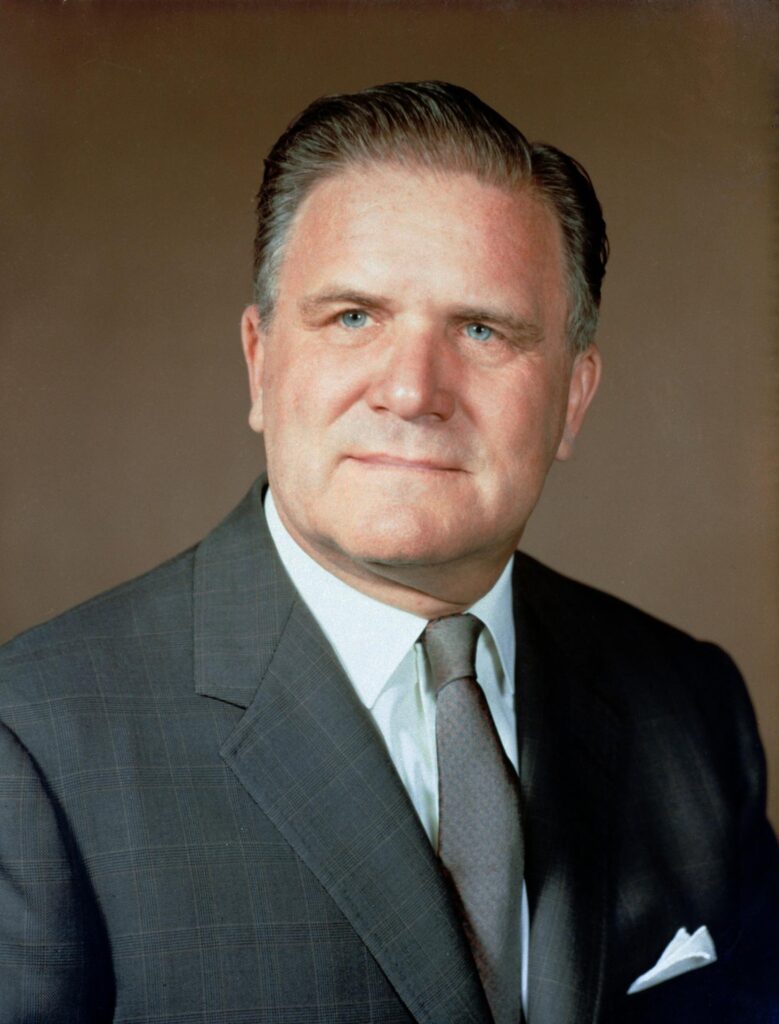James Webb was born on October 7, 1906, in Tally Ho, Granville County, North Carolina. His father was superintendent of schools in Granville County for 26 years. He received a Bachelor of Arts degree in Education from the University of North Carolina in 1928. He then enlisted as a second lieutenant in the Marine Corps and served as a pilot on active duty from 1930 to 1932. From 1932 until 1934, Webb was the secretary of Congressman Edward W. Pou of North Carolina. He next studied law at George Washington University from 1934 to 1936 and was admitted to the Bar of the District of Columbia in 1936.
In 1936, James Webb also became personnel director, secretary-treasurer, and later vice president of the Sperry Gyroscope Company in Brooklyn, New York. In 1944, he re-enlisted in the U.S. Marine Corps until 1945, then returned to Washington to serve as executive assistant to O. Max Gardner, Under Secretary of the Treasury. Webb was next to the director of the Bureau of the Budget in the Executive Office of the President, a position he held until 1949, when he was named Under Secretary of State, for the U.S. Department of State. With the end of the Truman administration in 1953, Webb left Washington for a position in the Kerr-McGee Oil Corporation in Oklahoma City, Oklahoma.
James Webb returned to Washington D.C. on February 14, 1961, to be the second administrator of the National Aeronautics and Space Administration (NASA). He was neither a scientist nor an engineer, and many in the agency were uneasy as he began his tenure. His obvious competence soon quieted his critics, however, and under his direction, NASA undertook one of the most impressive projects in history, to land an American on the Moon before the end of the decade through the execution of Project Apollo.
At the height of the Apollo program, Webb was responsible for 35,000 employees and more than 400,000 contractors working for thousands of companies and universities across the United States. When NASA and all of America were shaken by the deaths of the three Apollo 1 astronauts in a pad fire at Cape Kennedy in January 1967, Webb assumed much of the responsibility for the disaster. For the next year and a half, he worked tirelessly to restore confidence in NASA, among the general public and within the agency itself. His efforts succeeded with Apollo 7, America’s successful return to space, launched on October 11, 1968, just three days after James Webb resigned from NASA.
In his seven years at NASA, Webb had supervised the launching of more than 75 space science missions, manned and unmanned. He led the effort to develop robotic spacecraft such as the Surveyor program, which explored the lunar environment, and provided information that enabled the Apollo astronauts to land on the moon in 1969. Webb also supervised America’s first scientific probes to Mars and Venus, and in 1965, began advocating construction of a major space telescope. Initially known as the Large Space Telescope, his proposals would eventually result in the Hubble Space Telescope (HST), launched in 1991. Since its repair in 1993, the HST has greatly expanded mankind’s understanding of the universe.
After his retirement, James Webb remained active in the public sector, including service as a Regent of the Smithsonian Institution. He died on March 27, 1992, and is buried in Arlington National Cemetery.
In 2002, NASA Administrator Sean O’Keefe announced the new name for the next generation space telescope. “It is fitting that Hubble’s successor be named in honor of James Webb. Thanks to his efforts, we got our first glimpses at the dramatic landscape of outer space. He took our nation on its first voyages of exploration, turning our imagination into reality. Indeed, he laid the foundations at NASA for one of the most successful periods of astronomical discovery. As a result, we’re rewriting the textbooks today with the help of the Hubble Space Telescope, the Chandra X-ray Observatory, and the James Webb Telescope.”
James E. Webb, the manager who was neither a scientist nor an engineer, will be remembered not only for his role in the Apollo program but also for his support for the first proposed space telescope when the James Webb Space Telescope, the successor to the HST, is launched in 2013.

